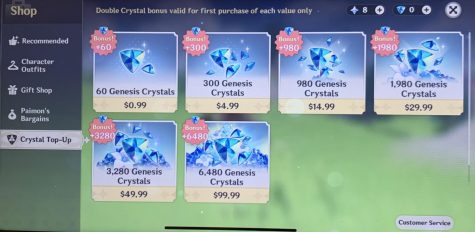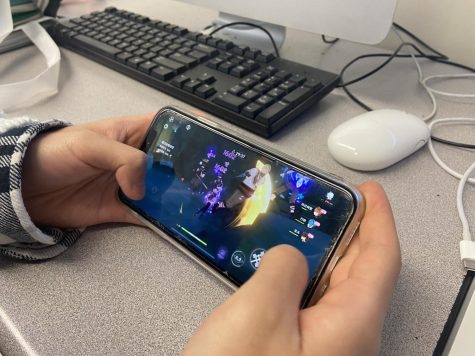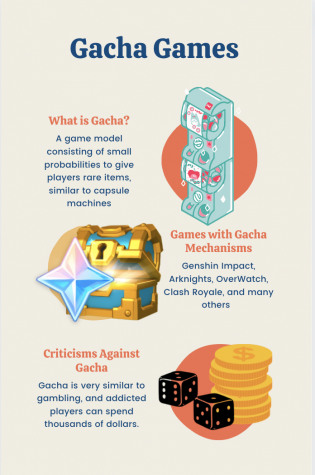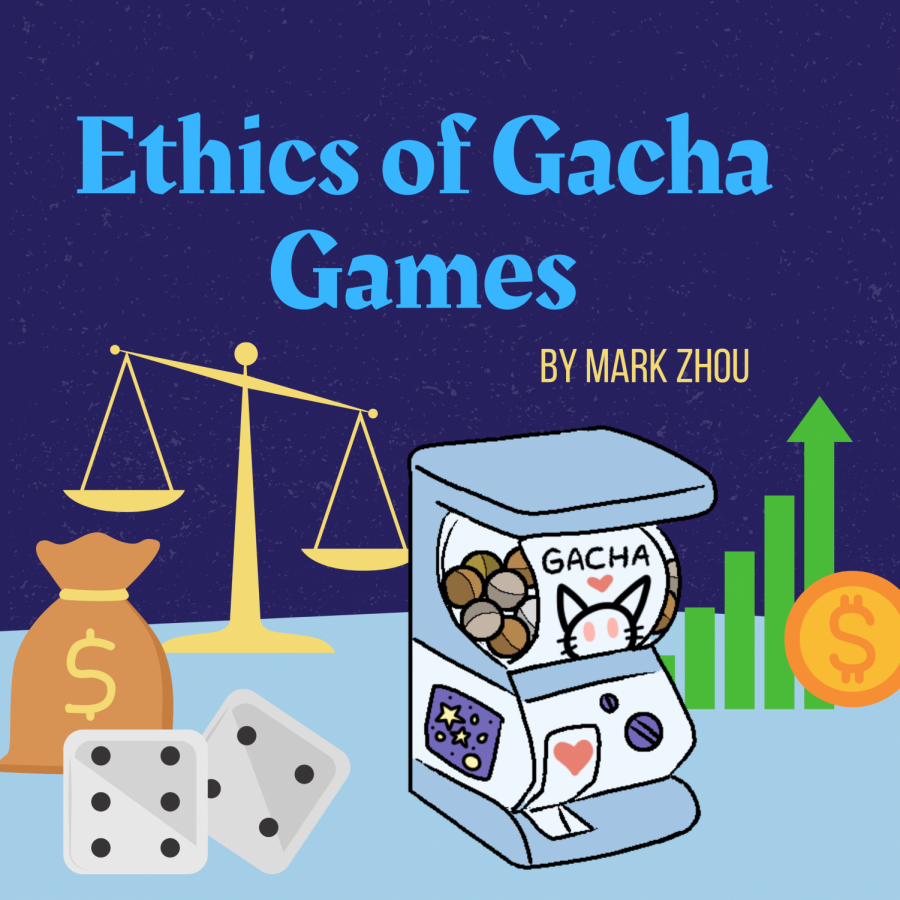Ethics of gacha games
Gacha games are one of the driving forces in the gaming industry. Are they innovative and thrilling, or are they the exploitative tools of greedy companies?
December 17, 2021
The gaming industry is expanding rapidly, especially among young people, and much of the expansion can be attributed to gacha games. The gacha model refers to “gachapon,” Japanese vending machines that sell collectible capsule items. In games, this translates to low chances to obtain rare items from game components like loot-boxes, chests, or wishes, causing players to spend money for more chances at success. The gacha system is a large source of revenue for many popular games worldwide, such as Clash Royale, Overwatch, Final Fantasy, and Genshin Impact. However, there is much controversy about this mechanism.
History of gacha
The gacha game model originated with the 2010 Japanese game “Dragon Collection,” in which players could obtain more than 7000 monsters, upgrade them, and use them in battle. Since then, gacha games have drastically increased in popularity and become an integral part of Japanese culture as many of the most popular Japanese games are gacha. There are many different types of gacha mechanisms. For example, in complete gacha, multiple pieces of items have to be combined to obtain a whole item; inbox gacha, the probabilities of an outcome are known and an item is guaranteed if enough money is spent.
Despite its tremendous success, the gacha mechanism led to controversy in Japan, with critics comparing it to gambling. In 2012, one of Japan’s five national newspapers published an article criticizing the gacha system that led to government investigations and eventually the ban of the “complete gacha” model, causing a sudden $3.8 billion plunge on game stocks.
However, gacha games quickly improved their models by, for example, guaranteeing an item if enough draws are made in a “pity system”, and has continued to strive in Japan and expand globally.
Current state of gacha

Today, gacha games are prevalent. Although not often associated with the term “gacha,” many Western games have adopted the mechanism. For example, the popular mobile game Clash Royale has a chest-opening system for obtaining cards that are crucial to gameplay. Gacha games originating from Asia, such as Genshin Impact, are more associated with the term: their gacha systems are often more important to gameplay and monetization.
These Asian gacha games are especially effective at monetization due to the critical connection between gacha and enjoyment of the game: players have irresistible urges to obtain certain characters, causing many to spend money. In addition, the games are almost all free-to-play, meaning that downloading the games is free and it is always a voluntary decision to spend money.
Concerns
A major concern regarding gacha games is that it attracts young players and expose them to a system similar to gambling.
“I think gacha is gambling because the two are both probability related, but what separates gacha from casino gambling is that gacha games have the pity system programmed into them,” said Myra Qin (’23), who doesn’t spend money on games (free-to-play).
Similar to gambling, gacha can be very expensive. If unlucky, a player in the game Genshin Impact can spend up to about $450 to guarantee to obtain a character through the pity system. In order to obtain other items, such as accessories for characters, double, or even triple this base-level amount can be required. Gacha games are often described as “pay-to-win,” meaning that only money, not skill, is needed to be successful in the game.

There is also the influence of well-known players that spend a lot, often referred to as “whales.” Many whales show themselves spending thousands of dollars on platforms like YouTube or Twitch. One YouTuber, Tony To, revealed in a video that he has spent over $7000 on Genshin Impact. Critics condemn the lavish spending, suggesting that they encourage viewers to spend more money.
The reality of gacha games

Game companies need profit to survive and improve, but contrary to many people’s beliefs, gacha games don’t exploit their players to meet their profits.
“I don’t think gacha games are exploiting their players. Gacha is the primary way they make revenue [instead of] using ads or making the game cost money to download,” said Sarah Zhang (’23), a free-to-play gacha game player.
Even though many young people play gacha games, very few actually spend copious amounts of money. In fact, gacha games earn the majority of their revenue from an extremely small percent of players who throw their money — the whales. In other words, most gacha gamers can enjoy the games without spending or by spending very little because the whales are enough to support the companies.
The majority of the whales are YouTubers or online streamers who play games for a living; they are simply utilizing the mutual dependency between them and the game companies.
“miHoYo, the game company, pays for everything in my life. I like to support the company that supports me. If I was not a content creator, I would not be spending a dime on Genshin Impact,” explained Genshin Impact streamer and Youtuber Tectone about why he spends tens of thousands of dollars on the game.
It’s true that in-game progress can be boosted by spending money, but free-to-play players can still gain significant progress and enjoy gacha games with patience.
“As long as you save the in-game currency, certain characters are guaranteed. I think there is still joy and satisfaction from obtaining a character after months of saving, and the high prices are reasonable because game companies are businesses who want to make profits,” said light spender Julia Shen (‘22).
Since gacha game companies make tremendous amounts of revenue, they can invest in their games and improve the experience for players. Genshin Impact is a great example of this. The game made $2 billion in its first year, but it had one of the highest budgets in the industry — $100 million. The game also costs $200 million to maintain and develop every year, a significant portion of the profits. This enormous budget goes into the beautiful graphics, frequent major updates and events, and professional music performed by world-tier orchestras such as the London Philharmonic and Tokyo Philharmonic.
Still, there are many regulations regarding harmful gacha mechanisms. Countries in the European Union have banned several gacha mechanism games that are deemed too close to gambling – for example, Belgium removed the loot-box purchases in OverWatch. The Apple App Store requires all games to disclose the chances to obtain items. Unlike when gacha was new in Japan and companies were unrestricted in their practices, they are now under strict regulations and the influence of the widespread public negativity towards game monetization.
Parents should warn young children about gacha or similar game mechanisms and game addiction in general, but as the game industry expands, the public is becoming more aware of these issues. The vast majority of gacha players enjoy their games, while the gacha game companies are trying their best to gain profits and bring their players happiness at the same time.





